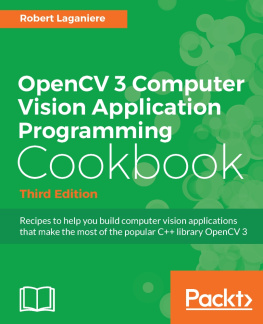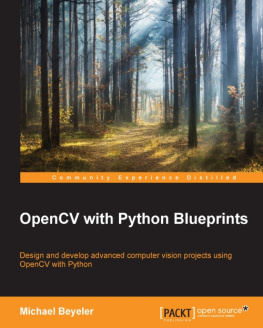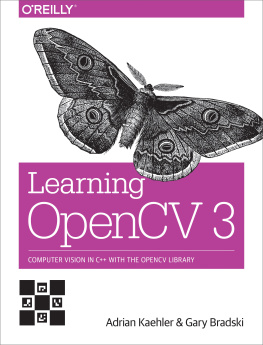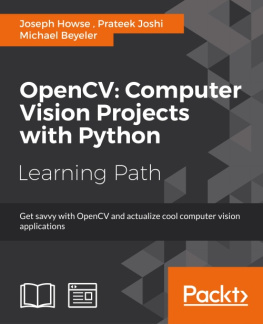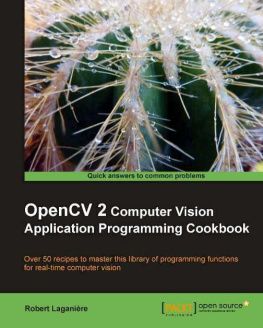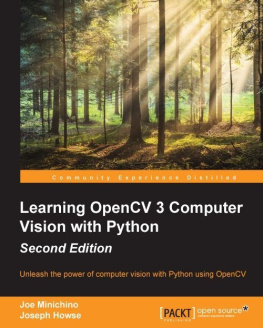OpenCV 3 Computer Vision Application Programming Cookbook - Third Edition
Copyright 2017 Packt Publishing
All rights reserved. No part of this book may be reproduced, stored in a retrieval system, or transmitted in any form or by any means, without the prior written permission of the publisher, except in the case of brief quotations embedded in critical articles or reviews.
Every effort has been made in the preparation of this book to ensure the accuracy of the information presented. However, the information contained in this book is sold without warranty, either express or implied. Neither the author, nor Packt Publishing, and its dealers and distributors will be held liable for any damages caused or alleged to be caused directly or indirectly by this book.
Packt Publishing has endeavored to provide trademark information about all of the companies and products mentioned in this book by the appropriate use of capitals. However, Packt Publishing cannot guarantee the accuracy of this information.
First published: May 2011
Second edition: August 2014
Third edition: February 2017
Production reference: 1070217
Published by Packt Publishing Ltd.
Livery Place
35 Livery Street
Birmingham
B3 2PB, UK.
ISBN 978-1-78646-971-7
www.packtpub.com
Credits
Author Robert Laganiere | Copy Editor Safis Editing |
Reviewer Luca Del Tongo | Project Coordinator Ulhas Kambali |
Commissioning Editor Edward Gordon | Proofreader Safis Editing |
Acquisition Editor Nitin Dasan | Indexer Tejal Daruwale Soni |
Content Development Editor Nikhil Borkar | Graphics Kirk D'Penha Jason Monteiro |
Technical Editor Subhalaxmi Nadar | Production Coordinator Shantanu Zagade |
About the Author
Robert Laganiere is a professor at the School of Electrical Engineering and Computer Science of the University of Ottawa, Canada. He is also a faculty member of the VIVA research lab and is the co-author of several scientific publications and patents in content-based video analysis, visual surveillance, driver-assistance, object detection, and tracking. Robert authored the OpenCV2 Computer Vision Application Programming Cookbook in 2011 and co-authored Object Oriented Software Development published by McGraw Hill in 2001. He co-founded Visual Cortek in 2006, an Ottawa-based video analytics startup that was later acquired by http://iwatchlife.com/ in 2009. He is also a consultant in computer vision and has assumed the role of Chief Scientist in a number of startups companies such as Cognivue Corp, iWatchlife, and Tempo Analytics. Robert has a Bachelor of Electrical Engineering degree from Ecole Polytechnique in Montreal (1987) and MSc and PhD degrees from INRS-Telecommunications, Montreal (1996).Visit the authors website at http://www.laganiere.name/.
I wish to thank all my students at the VIVA lab; I learn so much from them.
About the Reviewer
Luca Del Tongo is a computer engineer with a strong passion for algorithms, computer vision, and image processing techniques. He's the coauthor of a free e-book called Data Structures and Algorithms (DSA) with over 100k downloads so far and has published several image processing tutorials on his YouTube channel using Emgu CV. During his master's thesis, he developed an image forensic algorithm published in a scientific paper called Copy Move forgery detection and localization by means of robust clustering with J-Linkage. Currently, Luca works as a software engineer in the ophthalmology field developing corneal topography, processing algorithms, IOL calculation, and computerized chart projector. He loves to play sport and follow MOOC courses in his spare time.
You can contact him through his blog at http://blogs.ugidotnet.org/wetblog.
www.PacktPub.com
For support files and downloads related to your book, please visit www.PacktPub.com.
Did you know that Packt offers eBook versions of every book published, with PDF and ePub files available? You can upgrade to the eBook version at www.PacktPub.com and as a print book customer, you are entitled to a discount on the eBook copy. Get in touch with us at service@packtpub.com for more details.
At www.PacktPub.com, you can also read a collection of free technical articles, sign up for a range of free newsletters and receive exclusive discounts and offers on Packt books and eBooks.
https://www.packtpub.com/mapt
Get the most in-demand software skills with Mapt. Mapt gives you full access to all Packt books and video courses, as well as industry-leading tools to help you plan your personal development and advance your career.
Why subscribe?
- Fully searchable across every book published by Packt
- Copy and paste, print, and bookmark content
- On demand and accessible via a web browser
Customer Feedback
Thank you for purchasing this Packt book. We take our commitment to improving our content and products to meet your needs seriouslythat's why your feedback is so valuable. Whatever your feelings about your purchase, please consider leaving a review on this book's Amazon page. Not only will this help us, more importantly it will also help others in the community to make an informed decision about the resources that they invest in to learn.
You can also review for us on a regular basis by joining our reviewers' club. If you're interested in joining, or would like to learn more about the benefits we offer, please contact us : customerreviews@packtpub.com.
Preface
Augmented reality, driving assistance, video monitoring; more and more applications are now using computer vision and image analysis technologies, and yet we are still in the infancy of the development of new computerized systems capable of understanding our worlds through the sense of vision. And with the advent of powerful and affordable computing devices and visual sensors, it has never been easier to create sophisticated imaging applications. A multitude of software tools and libraries manipulating images and videos are available, but for anyone who wishes to develop smart vision-based applications, the OpenCV library is the tool to use.OpenCV (Open source Computer Vision) is an open source library containing more than 500 optimized algorithms for image and video analysis. Since its introduction in 1999, it has been largely adopted as the primary development tool by the community of researchers and developers in computer vision. OpenCV was originally developed at Intel by a team led by Gary Bradski as an initiative to advance research in vision and promote the development of rich vision-based, CPU-intensive applications. After a series of beta releases, version 1.0 was launched in 2006. A second major release occurred in 2009 with the launch of OpenCV 2 that proposed important changes, especially the new C++ interface, which we use in this book. In 2012, OpenCV reshaped itself as a non-profit foundation (http://opencv.org/) relying on crowdfunding for its future development. OpenCV3 was introduced in 2013; changes were made mainly to improve the usability of library. Its structure has been revised to remove the unnecessary dependencies, large modules have been split into smaller ones and the API has been refined.This book is the third edition of the

